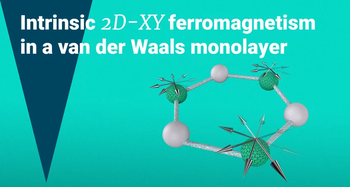Magnetism in Two Dimensions Goes “Easy-Plane”
More than fifty years ago it was understood by theoretical physicists that magnetism cannot exist in two dimensional systems. The recent renaissance in the nanoscale fabrication of atomically layered materials has enabled these long-standing notions to be tested experimentally. A special class of layered materials are those in which thin two-dimensional sheets are held together via “weak” van der Waals forces in the third dimension, such that they can be exfoliated as atomically thin sheets. A prime example is graphene that is a single layer of carbon atoms exfoliated from bulk graphite. Today many other such van der Waals compounds are known. Some of these that display magnetic properties have been exfoliated and studied in the single-atomic-layer limit. Not all of these are ferromagnetic such that they display a magnetic moment in the absence of a magnetic field. The key to observe such a magnetic moment in two dimensions is the existence of a stabilizing energy: a strong easy-axis magnetic anisotropy. This means that a magnet will align its north and south poles along one given direction, so that changes in the direction of the magnetic moment is resistant to external perturbations, such as thermal fluctuations.
There is another class of more exotic magnets, which rather prefer to align their moments within a geometrical plane. These are called easy-plane magnets, that are more difficult to realize in two dimensions, but offer extraordinary properties. One example is “superfluid spin transport” in which electron spins (the spin angular momentum of the rotating electron) can be transported through the material without any loss of energy. This could be a step towards energy-efficient electronic devices that use the electron spin as the active element for information processing, one important goal of the research field of Spintronics.
Now the dream of such “green” thinking devices is one step closer to reality. Scientists from the Max Planck Institute for Microstructure Physics in Halle, Germany, the ALBA synchrotron light source in Barcelona, Spain, and the Helmholtz-Zentrum Berlin, Germany have succeeded for the first time in creating a uniform two-dimensional “easy-plane” magnet. Moreover, the two-dimensional material CrCl3 was prepared not by the widely used “exfoliation” method, but rather using a scalable deposition technique under ultra-high-vacuum conditions, namely molecular beam epitaxy, which is compatible with large-scale production facilities. “We have developed unique, highly advanced deposition and in-situ characterization facilities to be able to explore and identify atomically-engineered materials with extraordinary properties. A single atomic layer of chromium trichloride on graphene, displaying two-dimensional easy-plane anisotropy, is one of our most recent success stories.” explains Prof. Stuart Parkin, Director at the Max-Planck Institute of Microstructure Physics, Halle, Germany, where the research study was carried out. Using fully in-situ methods, that is, without exposing the 2D material to air, the researchers have unveiled the intrinsic magnetic properties of a single, quasi-freestanding atomic layer of CrCl3 on a graphene-on-silicon-carbide substrate. Dr. Amilcar Bedoya-Pinto, a senior researcher at MPI Halle, explains the strategy: “The purpose of the graphene underlayer was to reduce the interaction between chromium chloride and silicon carbide and thereby prevent the substrate from influencing the properties of the CrCl3 layer. In that way, we obtained a quasi-freestanding monoatomic layer with the correct crystalline symmetry, a key to access the so far elusive magnetic easy-plane anisotropy in two dimensional systems.” During the measurements, which were carried out using the technique of X-ray magnetic circular dichroism in a synchrotron radiation facility, the researchers observed how this particular ferromagnetic order formed below a critical temperature, the Curie temperature. “In the monoatomic chromium chloride layer, a phase transition characteristic of easy-plane magnets took place that had never been observed before in such a clean two-dimensional system. We were happy to reproduce these novel results in two independent synchrotron beamlines, in VekMaG (BESSY, Berlin) and BOREAS (ALBA, Barcelona)”, reports Bedoya-Pinto.
This discovery will help to keep the topic of two-dimensional van der Waals magnets in the spotlight. “We now have an excellent platform for exploring a variety of physical phenomena that only exist in two-dimensional easy-plane magnets, such as superfluid (lossless) transport of spin”, Bedoya-Pinto is pleased to say. “With this proof of principle on hand, the goal towards applications is now to find or artificially engineer 2D magnets with ferromagnetic properties which are stable above room temperature. Then we can evaluate their performance for novel energy-efficient computing and thinking devices of great interest for technological applications” adds Prof. Stuart Parkin, one of the world-leading experts in magnetism and spintronics. He created the materials that enable novel devices that exhibit a giant tunneling magnetoresistance effect at room temperature that are used for several spintronic devices, such as the magnetic recording read heads in magnetic hard disk drives (HDDs) and a non-volatile, high performance magnetic random access memory (MRAM). Prof. Parkin is looking forward to taking advantage of the distinct fundamental properties of two-dimensional magnetic materials for novel and impactful information technologies.
-
The News was originally published by the Max Planck Institute of Microstructure Physics.
-
Contact:
Amilcar Bedoya-Pinto
+49 345 5582 724
amilcar.bedoya_pinto@mpi-halle.mpg.de
Jingrong Ji
+49 345 5582 621
Paolo Sessi
+49 345 5582 911
Stuart S. P. Parkin
+49 345 5582 657
stuart.parkin@mpi-halle.mpg.de
-
Publication:
“Science (2021): Intrinsic 2D-XY ferromagnetism in a van der Waals monolayer. Amilcar Bedoya-Pinto, Jing-Rong Ji, Avanindra Pandeya, Pierluigi Gargiani, Manuel Valvidares, Paolo Sessi, James Taylor, Florin Radu, Kai Chang and Stuart S.P. Parkin

